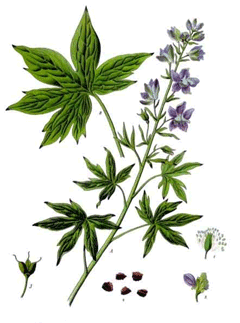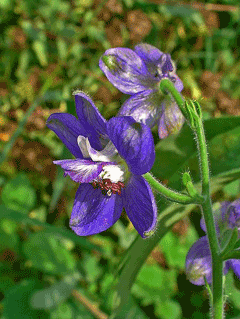 |
|
http://commons.wikimedia.org/wiki/File:Koeh-052.jpg |
 |
| http://commons.wikimedia.org/wiki/User:Llez |
Translate this page:
Summary
Physical Characteristics

 Delphinium staphisagria is a BIENNIAL/PERENNIAL growing to 1 m (3ft 3in).
Delphinium staphisagria is a BIENNIAL/PERENNIAL growing to 1 m (3ft 3in).
See above for USDA hardiness. It is hardy to UK zone 8. It is in flower from May to August. The species is hermaphrodite (has both male and female organs).
Suitable for: light (sandy), medium (loamy) and heavy (clay) soils, prefers well-drained soil and can grow in nutritionally poor soil. Suitable pH: mildly acid, neutral and basic (mildly alkaline) soils. It cannot grow in the shade. It prefers moist soil.
UK Hardiness Map
US Hardiness Map
Synonyms
Plant Habitats
Cultivated Beds;
Edible Uses
References More on Edible Uses
Medicinal Uses
Plants For A Future can not take any responsibility for any adverse effects from the use of plants. Always seek advice from a professional before using a plant medicinally.
Antispasmodic Cathartic Emetic Homeopathy Odontalgic Parasiticide Sialagogue Vermifuge
Warts
Stavesacre is a very poisonous plant that is rarely used in modern herbal medicine[238]. The seed is antispasmodic, cathartic, emetic and vermifuge[4, 44]. The seeds cause a strong salivation if they are chewed and have been used in the treatment of toothache and other painful conditions of the throat and gums[232]. They are so strongly emetic and cathartic, however, that they are rarely used internally[4]. Externally, a decoction is used to treat itchy skin and parasites4]. The seed is very poisonous and should be used with great caution[4]. The plant has been used externally in the treatment of warts, lice and itches[232]. A homeopathic remedy is made from the seeds[232]. This is used in the treatment of a variety of ailments including toothache, injuries and headache[232].
References More on Medicinal Uses
The Bookshop: Edible Plant Books
Our Latest books on Perennial Plants For Food Forests and Permaculture Gardens in paperback or digital formats.

Edible Tropical Plants
Food Forest Plants for Hotter Conditions: 250+ Plants For Tropical Food Forests & Permaculture Gardens.
More

Edible Temperate Plants
Plants for Your Food Forest: 500 Plants for Temperate Food Forests & Permaculture Gardens.
More

More Books
PFAF have eight books available in paperback and digital formats. Browse the shop for more information.
Shop Now
Other Uses
Insecticide Parasiticide
A parasiticide is obtained from the leaves[172]. It is quite toxic and so is for external use only. The seed is used to make a potent insecticide, parasiticide and to destroy vermin[4, 61, 89, 100, 238]. It is used to kill head lice[238].
Special Uses
References More on Other Uses
Cultivation details
Succeeds in most soils and situations[4] but prefers a rich well-drained neutral to alkaline soil[4, 200, 238] and is intolerant of winter-wet soils[200]. Requires an open sunny position[188]. This species is not hardy in the colder areas of the country, it tolerates temperatures down to between -5 and -10°c[200]. A greedy plant, inhibiting the growth of nearby plants, especially legumes[54].
References Carbon Farming Information and Carbon Sequestration Information
Temperature Converter
Type a value in the Celsius field to convert the value to Fahrenheit:
Fahrenheit:
The PFAF Bookshop
Plants For A Future have a number of books available in paperback and digital form. Book titles include Edible Plants, Edible Perennials, Edible Trees,Edible Shrubs, Woodland Gardening, and Temperate Food Forest Plants. Our new book is Food Forest Plants For Hotter Conditions (Tropical and Sub-Tropical).
Shop Now
Plant Propagation
Seed - sow March in a cold frame or April outdoors. Keep moist and in a shady position until germination takes place[175]. Seed can also be sown either in a cold frame or in situ as soon as it is ripe in mid to late summer[175], though seedlings from the outdoor sowing can be killed in cold winters[K]. The seed has a limited viability so it should be stored in a sealed container at about 3°c[200]. Temperatures above 15°c inhibit germination[175]. The seed usually germinates in 2 - 9 weeks at 15°c[175].
Other Names
If available other names are mentioned here
Native Range
TEMPERATE ASIA: Lebanon, Syria, Turkey EUROPE: Albania, Bosnia and Herzegovina, Greece (incl. Crete), Croatia, Italy (incl. Sardinia, Sicily), Montenegro, Slovenia, Spain (incl. Baleares), France (incl. Corsica), Portugal AFRICA: Spain (Canarias), Algeria, Morocco, Tunisia
Weed Potential
Right plant wrong place. We are currently updating this section.
Please note that a plant may be invasive in one area but may not in your area so it's worth checking.
Conservation Status
IUCN Red List of Threatened Plants Status :

Growth: S = slow M = medium F = fast. Soil: L = light (sandy) M = medium H = heavy (clay). pH: A = acid N = neutral B = basic (alkaline). Shade: F = full shade S = semi-shade N = no shade. Moisture: D = dry M = Moist We = wet Wa = water.
Now available:
Food Forest Plants for Mediterranean Conditions
350+ Perennial Plants For Mediterranean and Drier Food Forests and Permaculture Gardens.
[Paperback and eBook]
This is the third in Plants For A Future's series of plant guides for food forests tailored to
specific climate zones. Following volumes on temperate and tropical ecosystems, this book focuses
on species suited to Mediterranean conditions—regions with hot, dry summers and cool, wet winters,
often facing the added challenge of climate change.
Read More
Expert comment
Author
L.
Botanical References
200
Links / References
For a list of references used on this page please go here
Readers comment
| Add a comment |
|
If you have important information about this plant that may help other users please add a comment or link below. Only comments or links that are felt to be directly relevant to a plant will be included. If you think a comment/link or information contained on this page is inaccurate or misleading we would welcome your feedback at [email protected]. If you have questions about a plant please use the Forum on this website as we do not have the resources to answer questions ourselves.
* Please note: the comments by website users are not necessarily those held by PFAF and may give misleading or inaccurate information.
To leave a comment please Register or login here All comments need to be approved so will not appear immediately.
|
Subject : Delphinium staphisagria
|
|
|
|